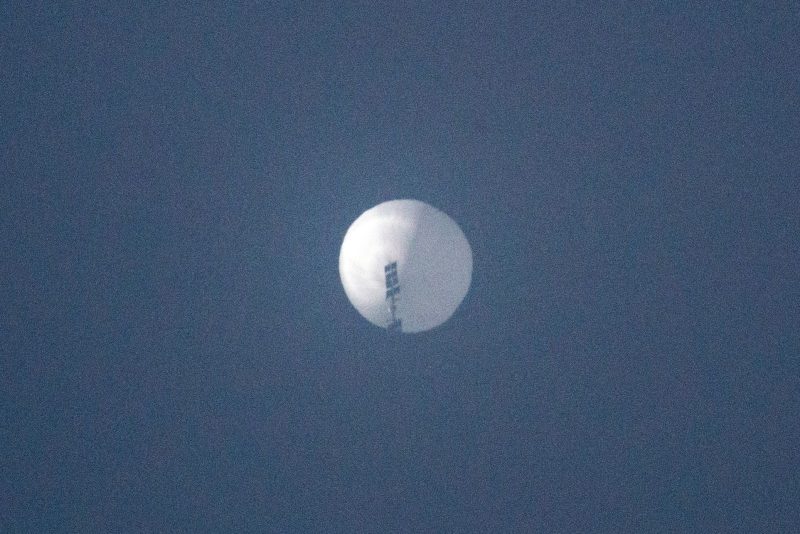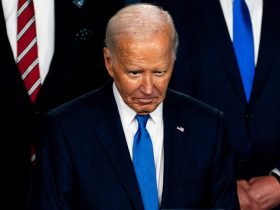The White House on Monday said that the three flying objects shot down over U.S. and Canadian airspace since Friday appear to be less sophisticated than the Chinese balloon found earlier this month but that they were targeted when they were found in a widening detection effort and it was determined their altitude could pose a threat to air traffic.
The three objects — spotted over Alaska, Canada and Michigan — were smaller than the suspected surveillance balloon, lacked communications signals and had no ability to maneuver themselves, National Security Council coordinator John Kirby said during a news briefing. They did, however, fly at much lower altitudes than the Chinese balloon, posing a “real risk” to civilian aircraft.
“A range of entities including countries, companies, research and academic organizations operate objects at these altitudes for purposes that are not nefarious at all,” Kirby said. “That said, because we have not yet been able to definitively assess what these most recent objects are, we acted out of an abundance of caution.
“And while we have no specific reason to suspect that they were conducting surveillance of any kind, we couldn’t rule that out,” he said, adding that “we need to separate” the Chinese balloon from the other three. “They didn’t have propulsion. They weren’t being maneuvered. It was basically they were being driven by the wind.”
Feb. 10: Object shot
down off the northern
coast of Alaska.
Feb. 11: Object shot down
over Canada’s Yukon
territory.
Feb. 12: Object
shot down over
Lake Huron.
CANADA
U.S.
The first balloon
came from China
and was spotted over
the Aleutian Islands
off Alaska and
southwestern
Montana.
Feb. 4: Balloon
shot down off
the South
Carolina coast.
THE WASHINGTON POST
Feb. 10: Object shot
down off the northern
coast of Alaska.
Feb. 11: Object
shot down over
Canada’s Yukon
territory.
Feb. 12: Object
shot down over
Lake Huron.
CHINA
CANADA
The first balloon
came from China
and was initially spotted
over the Aleutian Islands
off Alaska.
U.S.
Feb. 4: The first
balloon was shot
down off the South
Carolina coast.
THE WASHINGTON POST
U.S. authorities have ramped up detection efforts since the dramatic downing of the Chinese balloon on Feb. 4, modifying how they search for similar objects. “One of the reasons we think we’re seeing them is because we’re looking for them,” said Kirby. “If you set the parameters to look for a certain something it’s more likely you’re going to find a certain something.”
The latest object was shot down over Lake Huron in Michigan on Sunday afternoon, almost a day after it was detected near the U.S. border, traveling at an altitude of about 20,000 feet. Earlier, an object was shot down over Alaska on Friday and another in Canada’s Yukon territory on Saturday, both at an altitude close to 40,000 feet. Civilian commercial aircraft cruise at altitudes around 30,000 feet, putting the three objects much closer to air traffic than the Chinese balloon, which was operating at 60,000 feet.
It’s still unclear where the three objects originated, and no one has publicly come forward to claim ownership.
Recovery efforts are underway to salvage the downed objects, but finding them could be an arduous process. Those felled in Canada and Alaska are in icy, remote terrain, and the third shot down over Lake Huron “now lies in what is probably very deep water,” Kirby said. “We’re going to do everything we can to find them, and that will tell us a lot.”
While the United States has not described the three recently downed objects in great detail, Canadian officials characterized them on Monday as “lighter than air” with no propulsion systems and guided generally by wind currents. The object shot down in the Yukon territory, they said, was a “suspected balloon,” but harsh and remote conditions are hampering the recovery to confirm their assessments. The search area is about 3,000 square kilometers.
“We are working very hard to locate it, but there is no guarantee that we will,” said Sean McGillis, an acting deputy commissioner with the Royal Canadian Mounted Police. Similarly difficult conditions have affected the recovery at Lake Huron, he said. The object was first detected in southern Alberta.
Kirby also affirmed that salvage efforts for the Chinese balloon’s payload were ongoing off the South Carolina coast and could “take a long time,” but he said the U.S. military has been able to recover some debris, including electronics and part of the structure that was hanging from the Chinese airship. “We’re learning from it right now,” he said.
The discovery of the three additional objects has prompted questions about U.S. monitoring systems and how common such craft are in American airspace. On Monday, President Biden and his national security adviser, Jake Sullivan, gave the order to establish “an interagency team to study the broader policy implications for detection, analysis and disposition of unidentified aerial objects that pose either safety or security risks.” It was not immediately clear when this work would begin and what it would entail.
The Air Force’s top officer, Gen. Charles “CQ” Brown, said Monday that the discovery of the Chinese airship “got all of our attention.” Now that U.S. military officials have adjusted the sensitivity on radar to account for such a craft, he said, they are seeing more than they could see before.
“But we don’t fully appreciate and understand what we’re seeing,” Brown added. Once the recovery of remnants is completed, he said, “we’ll know more.”
Senators will receive a classified briefing on the objects on Tuesday and a separate classified meeting on the subject of China on Wednesday. Senate Minority Leader Mitch McConnell (R-Ky.) called on Biden to “level with” Americans and explain the administration’s decision to shoot down the objects.
“The public has seemingly heard about another new unidentified flying object seemingly on a daily basis,” McConnell said. “The administration has still not been able to divulge any meaningful information about what was shot down. What in the world is going on?”
Sen. Richard J. Durbin (Ill.), the No. 2 Senate Democrat, defended the administration’s approach. “I think they’re being careful,” he said. “This is kind of a shocking surprise that there’s so many objects floating around in space that might be a danger to us. I think [Biden’s] relying on the judgment of the military.”
But Durbin said he had a lot of questions about the recent shoot-downs and hoped the Senate would conduct more oversight. “Who put them up there?” he asked. “I think we know a lot about that first balloon, but these other three incidents — what’s behind all of it?”
Durbin compared the atmosphere now to that of the Cold War, saying that he believed the U.S.-China relationship would receive more congressional scrutiny going forward.
While U.S. officials have not linked China to the most recent objects, officials in Beijing hardened their rhetoric on Monday, accusing the United States of flying at least 10 unsanctioned balloons into its airspace in the past year. “The United States should first reflect on itself and change course, rather than slander, discredit or incite confrontation,” spokesman Wang Wenbin said at a regular news conference.
The White House issued a statement shortly after, denying the accusation. “This is the latest example of China scrambling to do damage control. It has repeatedly and wrongly claimed the surveillance balloon it sent over the United States was a weather balloon and to this day has failed to offer any credible explanations for its intrusion into our airspace and the airspace of others,” spokeswoman Adrienne Watson said.
Chinese officials maintain that the balloon shot down this month was a civilian craft used for scientific research that had veered off its intended course.
The tense back-and-forth over the balloon has dealt a sharp blow to tentative efforts for reconciliation between Beijing and Washington. On Monday, State Department spokesman Ned Price confirmed that U.S. and Chinese officials have been in touch since the balloon’s downing, but it remains unclear when Secretary of State Antony Blinken will reschedule a trip to China that he canceled after the incursion.
The top U.S. diplomat may have an opportunity to meet with China’s top foreign policy official, Wang Yi, on the sidelines of the Munich Security Conference later this week. “We’ll take a look at all of those options and if they make sense, given where we are in the bilateral relationship, and if it has the opportunity to be constructive and useful,” said Price.
U.S. officials have said the suspected spy balloon was linked to a broad program run by China’s military that spanned five continents more than 40 countries.
On Monday, the senior U.S. military officer overseeing U.S. air operations in the Middle East said his forces had previously spotted Chinese balloons in the area, most recently last fall. Lt. Gen. Alexus Grynkewich characterized them as “high-altitude” and “stratospheric,” and that they were not seen as threatening.
Unlike the three objects shot down since Friday, high-resolution images of the Chinese balloon captured during U-2 flybys showed it was capable of signals intelligence operations beyond the capabilities of regular weather balloons, potentially including tools to collect and locate communications, U.S. officials have said.
Lily Kuo in Taipei and John Hudson and Alex Horton in Washington contributed to this report.








